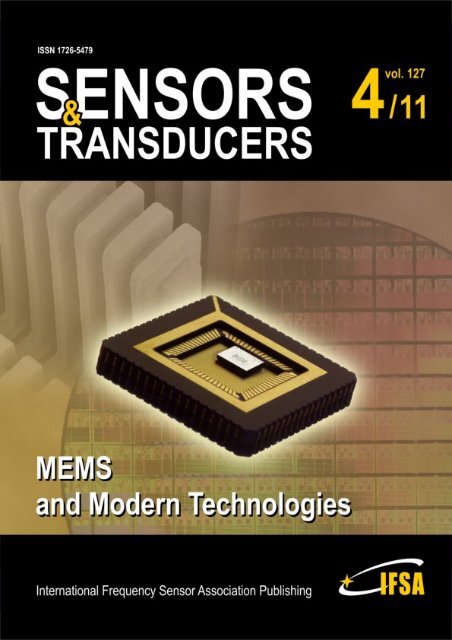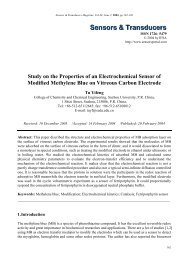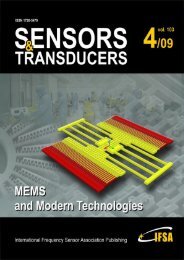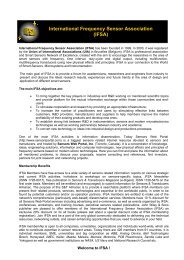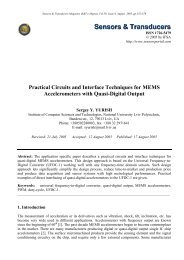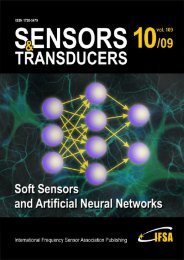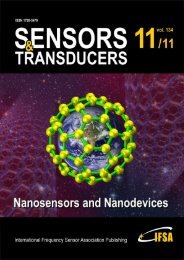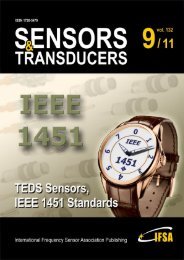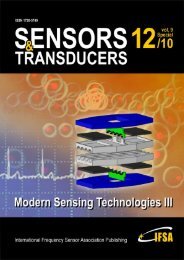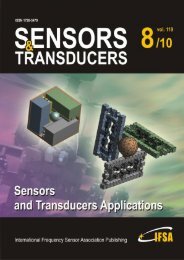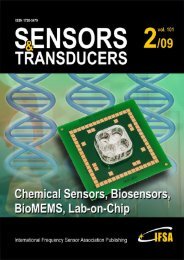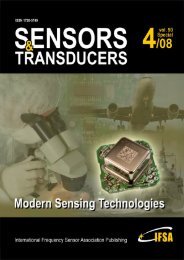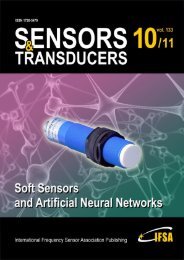Modeling and System-level Simulation of Force-balance MEMS ...
Modeling and System-level Simulation of Force-balance MEMS ...
Modeling and System-level Simulation of Force-balance MEMS ...
Create successful ePaper yourself
Turn your PDF publications into a flip-book with our unique Google optimized e-Paper software.
Sensors & Transducers<br />
Volume 127, Issue 4,<br />
April 2011<br />
www.sensorsportal.com ISSN 1726-5479<br />
Editors-in-Chief: pr<strong>of</strong>essor Sergey Y. Yurish, tel.: +34 696067716, fax: +34 93 4011989, e-mail: editor@sensorsportal.com<br />
Editors for Western Europe<br />
Meijer, Gerard C.M., Delft University <strong>of</strong> Technology, The Netherl<strong>and</strong>s<br />
Ferrari, Vittorio, Universitá di Brescia, Italy<br />
Editor South America<br />
Costa-Felix, Rodrigo, Inmetro, Brazil<br />
Editor for Eastern Europe<br />
Sachenko, Anatoly, Ternopil State Economic University, Ukraine<br />
Editors for North America<br />
Datskos, Panos G., Oak Ridge National Laboratory, USA<br />
Fabien, J. Josse, Marquette University, USA<br />
Katz, Evgeny, Clarkson University, USA<br />
Editor for Asia<br />
Ohyama, Shinji, Tokyo Institute <strong>of</strong> Technology, Japan<br />
Editor for Asia-Pacific<br />
Mukhopadhyay, Subhas, Massey University, New Zeal<strong>and</strong><br />
Editorial Advisory Board<br />
Abdul Rahim, Ruzairi, Universiti Teknologi, Malaysia<br />
Ahmad, Mohd Noor, Nothern University <strong>of</strong> Engineering, Malaysia<br />
Annamalai, Karthigeyan, National Institute <strong>of</strong> Advanced Industrial Science<br />
<strong>and</strong> Technology, Japan<br />
Arcega, Francisco, University <strong>of</strong> Zaragoza, Spain<br />
Arguel, Philippe, CNRS, France<br />
Ahn, Jae-Pyoung, Korea Institute <strong>of</strong> Science <strong>and</strong> Technology, Korea<br />
Arndt, Michael, Robert Bosch GmbH, Germany<br />
Ascoli, Giorgio, George Mason University, USA<br />
Atalay, Selcuk, Inonu University, Turkey<br />
Atghiaee, Ahmad, University <strong>of</strong> Tehran, Iran<br />
Augutis, Vygantas, Kaunas University <strong>of</strong> Technology, Lithuania<br />
Avachit, Patil Lalch<strong>and</strong>, North Maharashtra University, India<br />
Ayesh, Aladdin, De Montfort University, UK<br />
Azamimi, Azian binti Abdullah, Universiti Malaysia Perlis, Malaysia<br />
Bahreyni, Behraad, University <strong>of</strong> Manitoba, Canada<br />
Baliga, Shankar, B., General Monitors Transnational, USA<br />
Baoxian, Ye, Zhengzhou University, China<br />
Barford, Lee, Agilent Laboratories, USA<br />
Barlingay, Ravindra, RF Arrays <strong>System</strong>s, India<br />
Basu, Sukumar, Jadavpur University, India<br />
Beck, Stephen, University <strong>of</strong> Sheffield, UK<br />
Ben Bouzid, Sihem, Institut National de Recherche Scientifique, Tunisia<br />
Benachaiba, Chellali, Universitaire de Bechar, Algeria<br />
Binnie, T. David, Napier University, UK<br />
Bisch<strong>of</strong>f, Gerlinde, Inst. Analytical Chemistry, Germany<br />
Bodas, Dhananjay, IMTEK, Germany<br />
Borges Carval, Nuno, Universidade de Aveiro, Portugal<br />
Bousbia-Salah, Mounir, University <strong>of</strong> Annaba, Algeria<br />
Bouvet, Marcel, CNRS – UPMC, France<br />
Brudzewski, Kazimierz, Warsaw University <strong>of</strong> Technology, Pol<strong>and</strong><br />
Cai, Chenxin, Nanjing Normal University, China<br />
Cai, Qingyun, Hunan University, China<br />
Campanella, Luigi, University La Sapienza, Italy<br />
Carvalho, Vitor, Minho University, Portugal<br />
Cecelja, Franjo, Brunel University, London, UK<br />
Cerda Belmonte, Judith, Imperial College London, UK<br />
Chakrabarty, Ch<strong>and</strong>an Kumar, Universiti Tenaga Nasional, Malaysia<br />
Chakravorty, Dipankar, Association for the Cultivation <strong>of</strong> Science, India<br />
Changhai, Ru, Harbin Engineering University, China<br />
Chaudhari, Gajanan, Shri Shivaji Science College, India<br />
Chavali, Murthy, N.I. Center for Higher Education, (N.I. University), India<br />
Chen, Jiming, Zhejiang University, China<br />
Chen, Rongshun, National Tsing Hua University, Taiwan<br />
Cheng, Kuo-Sheng, National Cheng Kung University, Taiwan<br />
Chiang, Jeffrey (Cheng-Ta), Industrial Technol. Research Institute, Taiwan<br />
Chiriac, Horia, National Institute <strong>of</strong> Research <strong>and</strong> Development, Romania<br />
Chowdhuri, Arijit, University <strong>of</strong> Delhi, India<br />
Chung, Wen-Yaw, Chung Yuan Christian University, Taiwan<br />
Corres, Jesus, Universidad Publica de Navarra, Spain<br />
Cortes, Camilo A., Universidad Nacional de Colombia, Colombia<br />
Courtois, Christian, Universite de Valenciennes, France<br />
Cusano, Andrea, University <strong>of</strong> Sannio, Italy<br />
D'Amico, Arnaldo, Università di Tor Vergata, Italy<br />
De Stefano, Luca, Institute for Microelectronics <strong>and</strong> Microsystem, Italy<br />
Deshmukh, Kiran, Shri Shivaji Mahavidyalaya, Barshi, India<br />
Dickert, Franz L., Vienna University, Austria<br />
Dieguez, Angel, University <strong>of</strong> Barcelona, Spain<br />
Dimitropoulos, Panos, University <strong>of</strong> Thessaly, Greece<br />
Ding, Jianning, Jiangsu Polytechnic University, China<br />
Djordjevich, Alex<strong>and</strong>ar, City University <strong>of</strong> Hong Kong, Hong Kong<br />
Donato, Nicola, University <strong>of</strong> Messina, Italy<br />
Donato, Patricio, Universidad de Mar del Plata, Argentina<br />
Dong, Feng, Tianjin University, China<br />
Drljaca, Predrag, Instersema Sensoric SA, Switzerl<strong>and</strong><br />
Dubey, Venketesh, Bournemouth University, UK<br />
Enderle, Stefan, Univ.<strong>of</strong> Ulm <strong>and</strong> KTB Mechatronics GmbH, Germany<br />
Erdem, Gursan K. Arzum, Ege University, Turkey<br />
Erkmen, Aydan M., Middle East Technical University, Turkey<br />
Estelle, Patrice, Insa Rennes, France<br />
Estrada, Horacio, University <strong>of</strong> North Carolina, USA<br />
Faiz, Adil, INSA Lyon, France<br />
Fericean, Sorin, Balluff GmbH, Germany<br />
Fern<strong>and</strong>es, Joana M., University <strong>of</strong> Porto, Portugal<br />
Francioso, Luca, CNR-IMM Institute for Microelectronics <strong>and</strong> Microsystems, Italy<br />
Francis, Laurent, University Catholique de Louvain, Belgium<br />
Fu, Weiling, South-Western Hospital, Chongqing, China<br />
Gaura, Elena, Coventry University, UK<br />
Geng, Yanfeng, China University <strong>of</strong> Petroleum, China<br />
Gole, James, Georgia Institute <strong>of</strong> Technology, USA<br />
Gong, Hao, National University <strong>of</strong> Singapore, Singapore<br />
Gonzalez de la Rosa, Juan Jose, University <strong>of</strong> Cadiz, Spain<br />
Granel, Annette, Goteborg University, Sweden<br />
Graff, Mason, The University <strong>of</strong> Texas at Arlington, USA<br />
Guan, Shan, Eastman Kodak, USA<br />
Guillet, Bruno, University <strong>of</strong> Caen, France<br />
Guo, Zhen, New Jersey Institute <strong>of</strong> Technology, USA<br />
Gupta, Narendra Kumar, Napier University, UK<br />
Hadjiloucas, Sillas, The University <strong>of</strong> Reading, UK<br />
Haider, Mohammad R., Sonoma State University, USA<br />
Hashsham, Syed, Michigan State University, USA<br />
Hasni, Abdelhafid, Bechar University, Algeria<br />
Hern<strong>and</strong>ez, Alvaro, University <strong>of</strong> Alcala, Spain<br />
Hern<strong>and</strong>ez, Wilmar, Universidad Politecnica de Madrid, Spain<br />
Homentcovschi, Dorel, SUNY Binghamton, USA<br />
Horstman, Tom, U.S. Automation Group, LLC, USA<br />
Hsiai, Tzung (John), University <strong>of</strong> Southern California, USA<br />
Huang, Jeng-Sheng, Chung Yuan Christian University, Taiwan<br />
Huang, Star, National Tsing Hua University, Taiwan<br />
Huang, Wei, PSG Design Center, USA<br />
Hui, David, University <strong>of</strong> New Orleans, USA<br />
Jaffrezic-Renault, Nicole, Ecole Centrale de Lyon, France<br />
Jaime Calvo-Galleg, Jaime, Universidad de Salamanca, Spain<br />
James, Daniel, Griffith University, Australia<br />
Janting, Jakob, DELTA Danish Electronics, Denmark<br />
Jiang, Liudi, University <strong>of</strong> Southampton, UK<br />
Jiang, Wei, University <strong>of</strong> Virginia, USA<br />
Jiao, Zheng, Shanghai University, China<br />
John, Joachim, IMEC, Belgium<br />
Kalach, Andrew, Voronezh Institute <strong>of</strong> Ministry <strong>of</strong> Interior, Russia<br />
Kang, Moonho, Sunmoon University, Korea South<br />
Kaniusas, Eugenijus, Vienna University <strong>of</strong> Technology, Austria<br />
Katake, Anup, Texas A&M University, USA<br />
Kausel, Wilfried, University <strong>of</strong> Music, Vienna, Austria<br />
Kavasoglu, Nese, Mugla University, Turkey<br />
Ke, Cathy, Tyndall National Institute, Irel<strong>and</strong><br />
Khelfaoui, Rachid, Université de Bechar, Algeria<br />
Khan, Asif, Aligarh Muslim University, Aligarh, India<br />
Kim, Min Young, Kyungpook National University, Korea South<br />
Ko, Sang Choon, Electronics. <strong>and</strong> Telecom. Research Inst., Korea South<br />
Kotulska, Malgorzata, Wroclaw University <strong>of</strong> Technology, Pol<strong>and</strong><br />
Kratz, Henrik, Uppsala University, Sweden<br />
Kockar, Hakan, Balikesir University, Turkey<br />
Kong, Ing, RMIT University, Australia
Kumar, Arun, University <strong>of</strong> South Florida, USA<br />
Kumar, Subodh, National Physical Laboratory, India<br />
Kung, Chih-Hsien, Chang-Jung Christian University, Taiwan<br />
Lacnjevac, Caslav, University <strong>of</strong> Belgrade, Serbia<br />
Lay-Ekuakille, Aime, University <strong>of</strong> Lecce, Italy<br />
Lee, Jang Myung, Pusan National University, Korea South<br />
Lee, Jun Su, Amkor Technology, Inc. South Korea<br />
Lei, Hua, National Starch <strong>and</strong> Chemical Company, USA<br />
Li, Genxi, Nanjing University, China<br />
Li, Hui, Shanghai Jiaotong University, China<br />
Li, Xian-Fang, Central South University, China<br />
Li, Yuefa, Wayne State University, USA<br />
Liang, Yuanchang, University <strong>of</strong> Washington, USA<br />
Liawruangrath, Saisunee, Chiang Mai University, Thail<strong>and</strong><br />
Liew, Kim Meow, City University <strong>of</strong> Hong Kong, Hong Kong<br />
Lin, Hermann, National Kaohsiung University, Taiwan<br />
Lin, Paul, C<strong>level</strong><strong>and</strong> State University, USA<br />
Linderholm, Pontus, EPFL - Microsystems Laboratory, Switzerl<strong>and</strong><br />
Liu, Aihua, University <strong>of</strong> Oklahoma, USA<br />
Liu Changgeng, Louisiana State University, USA<br />
Liu, Cheng-Hsien, National Tsing Hua University, Taiwan<br />
Liu, Songqin, Southeast University, China<br />
Lodeiro, Carlos, University <strong>of</strong> Vigo, Spain<br />
Lorenzo, Maria Encarnacio, Universidad Autonoma de Madrid, Spain<br />
Lukaszewicz, Jerzy Pawel, Nicholas Copernicus University, Pol<strong>and</strong><br />
Ma, Zhanfang, Northeast Normal University, China<br />
Majstorovic, Vidosav, University <strong>of</strong> Belgrade, Serbia<br />
Marquez, Alfredo, Centro de Investigacion en Materiales Avanzados, Mexico<br />
Matay, Ladislav, Slovak Academy <strong>of</strong> Sciences, Slovakia<br />
Mathur, Prafull, National Physical Laboratory, India<br />
Maurya, D.K., Institute <strong>of</strong> Materials Research <strong>and</strong> Engineering, Singapore<br />
Mekid, Samir, University <strong>of</strong> Manchester, UK<br />
Melnyk, Ivan, Photon Control Inc., Canada<br />
Mendes, Paulo, University <strong>of</strong> Minho, Portugal<br />
Mennell, Julie, Northumbria University, UK<br />
Mi, Bin, Boston Scientific Corporation, USA<br />
Minas, Graca, University <strong>of</strong> Minho, Portugal<br />
Moghavvemi, Mahmoud, University <strong>of</strong> Malaya, Malaysia<br />
Mohammadi, Mohammad-Reza, University <strong>of</strong> Cambridge, UK<br />
Molina Flores, Esteban, Benemérita Universidad Autónoma de Puebla,<br />
Mexico<br />
Moradi, Majid, University <strong>of</strong> Kerman, Iran<br />
Morello, Rosario, University "Mediterranea" <strong>of</strong> Reggio Calabria, Italy<br />
Mounir, Ben Ali, University <strong>of</strong> Sousse, Tunisia<br />
Mulla, Imtiaz Sirajuddin, National Chemical Laboratory, Pune, India<br />
Nabok, Aleksey, Sheffield Hallam University, UK<br />
Neelamegam, Periasamy, Sastra Deemed University, India<br />
Neshkova, Milka, Bulgarian Academy <strong>of</strong> Sciences, Bulgaria<br />
Oberhammer, Joachim, Royal Institute <strong>of</strong> Technology, Sweden<br />
Ould Lahoucine, Cherif, University <strong>of</strong> Guelma, Algeria<br />
Pamidighanta, Sayanu, Bharat Electronics Limited (BEL), India<br />
Pan, Jisheng, Institute <strong>of</strong> Materials Research & Engineering, Singapore<br />
Park, Joon-Shik, Korea Electronics Technology Institute, Korea South<br />
Penza, Michele, ENEA C.R., Italy<br />
Pereira, Jose Miguel, Instituto Politecnico de Setebal, Portugal<br />
Petsev, Dimiter, University <strong>of</strong> New Mexico, USA<br />
Pogacnik, Lea, University <strong>of</strong> Ljubljana, Slovenia<br />
Post, Michael, National Research Council, Canada<br />
Prance, Robert, University <strong>of</strong> Sussex, UK<br />
Prasad, Ambika, Gulbarga University, India<br />
Prateepasen, Asa, Kingmoungut's University <strong>of</strong> Technology, Thail<strong>and</strong><br />
Pullini, Daniele, Centro Ricerche FIAT, Italy<br />
Pumera, Martin, National Institute for Materials Science, Japan<br />
Radhakrishnan, S. National Chemical Laboratory, Pune, India<br />
Rajanna, K., Indian Institute <strong>of</strong> Science, India<br />
Ramadan, Qasem, Institute <strong>of</strong> Microelectronics, Singapore<br />
Rao, Basuthkar, Tata Inst. <strong>of</strong> Fundamental Research, India<br />
Rao<strong>of</strong>, Kosai, Joseph Fourier University <strong>of</strong> Grenoble, France<br />
Rastogi Shiva, K. University <strong>of</strong> Idaho, USA<br />
Reig, C<strong>and</strong>id, University <strong>of</strong> Valencia, Spain<br />
Restivo, Maria Teresa, University <strong>of</strong> Porto, Portugal<br />
Robert, Michel, University Henri Poincare, France<br />
Rezazadeh, Ghader, Urmia University, Iran<br />
Royo, Santiago, Universitat Politecnica de Catalunya, Spain<br />
Rodriguez, Angel, Universidad Politecnica de Cataluna, Spain<br />
Rothberg, Steve, Loughborough University, UK<br />
Sadana, Ajit, University <strong>of</strong> Mississippi, USA<br />
Sadeghian Marnani, Hamed, TU Delft, The Netherl<strong>and</strong>s<br />
S<strong>and</strong>acci, Serghei, Sensor Technology Ltd., UK<br />
Sapozhnikova, Ksenia, D.I.Mendeleyev Institute for Metrology, Russia<br />
Saxena, Vibha, Bhbha Atomic Research Centre, Mumbai, India<br />
Schneider, John K., Ultra-Scan Corporation, USA<br />
Sengupta, Deepak, Advance Bio-Photonics, India<br />
Seif, Selemani, Alabama A & M University, USA<br />
Seifter, Achim, Los Alamos National Laboratory, USA<br />
Shah, Kriyang, La Trobe University, Australia<br />
Silva Girao, Pedro, Technical University <strong>of</strong> Lisbon, Portugal<br />
Singh, V. R., National Physical Laboratory, India<br />
Slomovitz, Daniel, UTE, Uruguay<br />
Smith, Martin, Open University, UK<br />
Soleymanpour, Ahmad, Damghan Basic Science University, Iran<br />
Somani, Prakash R., Centre for Materials for Electronics Technol., India<br />
Srinivas, Talabattula, Indian Institute <strong>of</strong> Science, Bangalore, India<br />
Srivastava, Arvind K., NanoSonix Inc., USA<br />
Stefan-van Staden, Raluca-Ioana, University <strong>of</strong> Pretoria, South Africa<br />
Sumriddetchka, Sarun, National Electronics <strong>and</strong> Computer Technology Center,<br />
Thail<strong>and</strong><br />
Sun, Chengliang, Polytechnic University, Hong-Kong<br />
Sun, Dongming, Jilin University, China<br />
Sun, Junhua, Beijing University <strong>of</strong> Aeronautics <strong>and</strong> Astronautics, China<br />
Sun, Zhiqiang, Central South University, China<br />
Suri, C. Raman, Institute <strong>of</strong> Microbial Technology, India<br />
Sysoev, Victor, Saratov State Technical University, Russia<br />
Szewczyk, Roman, Industrial Research Inst. for Automation <strong>and</strong> Measurement,<br />
Pol<strong>and</strong><br />
Tan, Ooi Kiang, Nanyang Technological University, Singapore,<br />
Tang, Dianping, Southwest University, China<br />
Tang, Jaw-Luen, National Chung Cheng University, Taiwan<br />
Teker, Kasif, Frostburg State University, USA<br />
Thirunavukkarasu, I., Manipal University Karnataka, India<br />
Thumbavanam Pad, Kartik, Carnegie Mellon University, USA<br />
Tian, Gui Yun, University <strong>of</strong> Newcastle, UK<br />
Tsiantos, Vassilios, Technological Educational Institute <strong>of</strong> Kaval, Greece<br />
Tsigara, Anna, National Hellenic Research Foundation, Greece<br />
Twomey, Karen, University College Cork, Irel<strong>and</strong><br />
Valente, Antonio, University, Vila Real, - U.T.A.D., Portugal<br />
Vanga, Raghav Rao, Summit Technology Services, Inc., USA<br />
Vaseashta, Ashok, Marshall University, USA<br />
Vazquez, Carmen, Carlos III University in Madrid, Spain<br />
Vieira, Manuela, Instituto Superior de Engenharia de Lisboa, Portugal<br />
Vigna, Benedetto, STMicroelectronics, Italy<br />
Vrba, Radimir, Brno University <strong>of</strong> Technology, Czech Republic<br />
W<strong>and</strong>elt, Barbara, Technical University <strong>of</strong> Lodz, Pol<strong>and</strong><br />
Wang, Jiangping, Xi'an Shiyou University, China<br />
Wang, Kedong, Beihang University, China<br />
Wang, Liang, Pacific Northwest National Laboratory, USA<br />
Wang, Mi, University <strong>of</strong> Leeds, UK<br />
Wang, Shinn-Fwu, Ching Yun University, Taiwan<br />
Wang, Wei-Chih, University <strong>of</strong> Washington, USA<br />
Wang, Wensheng, University <strong>of</strong> Pennsylvania, USA<br />
Watson, Steven, Center for NanoSpace Technologies Inc., USA<br />
Weiping, Yan, Dalian University <strong>of</strong> Technology, China<br />
Wells, Stephen, Southern Company Services, USA<br />
Wolkenberg, Andrzej, Institute <strong>of</strong> Electron Technology, Pol<strong>and</strong><br />
Woods, R. Clive, Louisiana State University, USA<br />
Wu, DerHo, National Pingtung Univ. <strong>of</strong> Science <strong>and</strong> Technology, Taiwan<br />
Wu, Zhaoyang, Hunan University, China<br />
Xiu Tao, Ge, Chuzhou University, China<br />
Xu, Lisheng, The Chinese University <strong>of</strong> Hong Kong, Hong Kong<br />
Xu, Sen, Drexel University, USA<br />
Xu, Tao, University <strong>of</strong> California, Irvine, USA<br />
Yang, Dongfang, National Research Council, Canada<br />
Yang, Shuang-Hua, Loughborough University, UK<br />
Yang, Wuqiang, The University <strong>of</strong> Manchester, UK<br />
Yang, Xiaoling, University <strong>of</strong> Georgia, Athens, GA, USA<br />
Yaping Dan, Harvard University, USA<br />
Ymeti, Aurel, University <strong>of</strong> Twente, Netherl<strong>and</strong><br />
Yong Zhao, Northeastern University, China<br />
Yu, Haihu, Wuhan University <strong>of</strong> Technology, China<br />
Yuan, Yong, Massey University, New Zeal<strong>and</strong><br />
Yufera Garcia, Alberto, Seville University, Spain<br />
Zakaria, Zulkarnay, University Malaysia Perlis, Malaysia<br />
Zagnoni, Michele, University <strong>of</strong> Southampton, UK<br />
Zamani, Cyrus, Universitat de Barcelona, Spain<br />
Zeni, Luigi, Second University <strong>of</strong> Naples, Italy<br />
Zhang, Minglong, Shanghai University, China<br />
Zhang, Qintao, University <strong>of</strong> California at Berkeley, USA<br />
Zhang, Weiping, Shanghai Jiao Tong University, China<br />
Zhang, Wenming, Shanghai Jiao Tong University, China<br />
Zhang, Xueji, World Precision Instruments, Inc., USA<br />
Zhong, Haoxiang, Henan Normal University, China<br />
Zhu, Qing, Fujifilm Dimatix, Inc., USA<br />
Zorzano, Luis, Universidad de La Rioja, Spain<br />
Zourob, Mohammed, University <strong>of</strong> Cambridge, UK<br />
Sensors & Transducers Journal (ISSN 1726-5479) is a peer review international journal published monthly online by International Frequency Sensor Association (IFSA).<br />
Available in electronic <strong>and</strong> on CD. Copyright © 2011 by International Frequency Sensor Association. All rights reserved.
Sensors & Transducers Journal<br />
Contents<br />
Volume 127<br />
Issue 4<br />
April 2011<br />
www.sensorsportal.com ISSN 1726-5479<br />
Research Articles<br />
Going Fabless with <strong>MEMS</strong><br />
Bhaskar Choubey ............................................................................................................................... 1<br />
Micromachined Polycrystalline Si Thermopiles in a T-shirt<br />
Vladimir Leonov, Yvonne van Andel, Ziyang Wang, Ruud J. M. Vullers <strong>and</strong> Chris Van Ho<strong>of</strong>........... 15<br />
Virtual Fabrication <strong>of</strong> Silicon Nitride Based Multifunctional <strong>MEMS</strong> Pressure Sensor<br />
Mahesh Kumar Patankar.................................................................................................................... 27<br />
General Development <strong>of</strong> a New Hall Effect Sensor<br />
Vlassis N. Petoussis, Panos D. Dimitropoulos, George Stamoulis.................................................... 36<br />
Inspection <strong>of</strong> Pipe Inner Surface using Advanced Pipe Crawler Robot with PVDF Sensor<br />
based Rotating Probe<br />
Vimal Agarwal, Harutoshi Ogai, Kentarou Nishijima <strong>and</strong> Bishakh Bhattacharya............................... 45<br />
Ultrasonic <strong>System</strong> Approach to Obstacle Detection <strong>and</strong> Edge Detection<br />
Yin Thu Win, Hla Thar Htun, Nitin Afzulpurkar, Chumnarn Punyasai ................................................ 56<br />
Monitoring <strong>of</strong> Various Glucose Concentrations Based on Optical Spectroscopic<br />
Reflectometry<br />
Hariyadi Soetedjo ............................................................................................................................... 69<br />
Studies <strong>of</strong> Gas Sensing Performance <strong>of</strong> Barium Zirconate (BaZrO 3 )<br />
R. M. Chaudhari, V. B. Gaikwad, P. D. Hire, R. L. Patil,S. D. Shinde, N. U. Patil, G. H. Jain. .......... 76<br />
<strong>Modeling</strong> <strong>and</strong> <strong>System</strong>-<strong>level</strong> <strong>Simulation</strong> <strong>of</strong> <strong>Force</strong>-<strong>balance</strong> <strong>MEMS</strong> Comb Accelerometers<br />
Hao Chen, Limei Xu ........................................................................................................................... 88<br />
Design <strong>and</strong> Fabrication <strong>of</strong> a Lab-on-a-chip for Point-<strong>of</strong>-care Diagnostics<br />
Anne Balck, Monika Michalzik, Laila Al-Halabi, Stefan Dübel, <strong>and</strong> Stephanus Büttgenbach............ 102<br />
Authors are encouraged to submit article in MS Word (doc) <strong>and</strong> Acrobat (pdf) formats by e-mail: editor@sensorsportal.com<br />
Please visit journal’s webpage with preparation instructions: http://www.sensorsportal.com/HTML/DIGEST/Submition.htm<br />
International Frequency Sensor Association (IFSA).
Sensors & Transducers Journal, Vol. 127, Issue 4, April 2011, pp. 88-101<br />
Sensors & Transducers<br />
ISSN 1726-5479<br />
© 2011 by IFSA<br />
http://www.sensorsportal.com<br />
<strong>Modeling</strong> <strong>and</strong> <strong>System</strong>-<strong>level</strong> <strong>Simulation</strong> <strong>of</strong> <strong>Force</strong>-<strong>balance</strong><br />
<strong>MEMS</strong> Comb Accelerometers<br />
Hao CHEN, Limei XU<br />
Institute <strong>of</strong> Astronautics & Aeronautics<br />
University <strong>of</strong> Electronic Science <strong>and</strong> Technology <strong>of</strong> China<br />
Chengdu, Sichuan 611731, China<br />
Tel.: 028-83205198<br />
E-mail: scuch@uestc.edu.cn<br />
Received: 10 April 2011 /Accepted: 22 April 2011 /Published: 30 April 2011<br />
Abstract: This paper presents a quick system-<strong>level</strong> modeling <strong>and</strong> simulation <strong>of</strong> force-<strong>balance</strong> <strong>MEMS</strong><br />
comb accelerometers. The derivation <strong>of</strong> the system-<strong>level</strong> model including the sense element <strong>and</strong><br />
interface electronics is elaborated <strong>and</strong> the simulation results are obtained from COVENTOR <strong>and</strong><br />
MATLAB respectively. The force-<strong>balance</strong> <strong>MEMS</strong> comb accelerometer, with the size <strong>of</strong> 1920 µm<br />
960 µm 50 µm, the static capacitance <strong>of</strong> 2.25 pF, <strong>and</strong> the inertial mass <strong>of</strong> 5.47 µg, can endure with<br />
over load <strong>of</strong> 2000 g. Through the system-<strong>level</strong> simulation, the sensitivity is 100 mv/g, the full scale<br />
range is 50<br />
g, the nonlinear distortion is smaller than 0.5 % <strong>and</strong> the system b<strong>and</strong>width is 2.2 kHz.<br />
Copyright © 2011 IFSA.<br />
Keywords: Micro-accelerometer; <strong>System</strong>-<strong>level</strong> simulation; Closed-loop system; Differential<br />
capacitive.<br />
1. Introduction<br />
Now, micro-machined sensors are widely used in many different aspects <strong>of</strong> inertial navigation system<br />
as well as the center <strong>of</strong> the vibration examination system for their small size, low cost <strong>and</strong> low power<br />
consumption. Especially, micro-machined accelerometers have been more <strong>and</strong> more popular since the<br />
safety requirement for automobiles has tightened, such like seat belts <strong>and</strong> air-bag systems. This leads<br />
to a high dem<strong>and</strong> for low-cost <strong>and</strong> small-size accelerometers capable <strong>of</strong> sensing up to 50 g (where 1 g<br />
is the acceleration due to earth gravitational force). Thus, integrated capacitive accelerometers that<br />
meet the requirements are well received [1-4]. There are many different types <strong>of</strong> micro-machined<br />
88
Sensors & Transducers Journal, Vol. 127, Issue 4, April 2011, pp. 88-101<br />
accelerometers, such as piezoresistive, piezoelectric, <strong>and</strong> capacitive accelerometer. But, most<br />
accelerometers use the capacitive-based mechanism because <strong>of</strong> its structural simplicity, high accuracy,<br />
low temperature sensitivity, low noise performance, good DC response, <strong>and</strong> compatibility with CMOS<br />
readout electronics. Capacitive accelerometers are typically implemented as a differential capacitance,<br />
using the linear relationship between the capacitance change <strong>and</strong> the acceleration [5]. Moreover, force<strong>balance</strong><br />
<strong>MEMS</strong> accelerometers based on capacitive mechanism can improve the system stability <strong>and</strong><br />
widen the measurement range using a closed loop structure [6].<br />
As <strong>MEMS</strong> technology continues to grow, to design <strong>and</strong> simulate <strong>MEMS</strong> device is becoming an<br />
interesting <strong>and</strong> important research issue. FEA/BEA is a commonly used numerical simulation method<br />
in <strong>MEMS</strong> simulation; firstly this method meshes the entity model <strong>and</strong> produces the system matrix, <strong>and</strong><br />
then solves the system matrix to get simulation result. In order to analyze the interaction between<br />
mechanical <strong>and</strong> electrostatic field, we must carry out the iterative calculation on both mechanical <strong>and</strong><br />
electrostatic field until the results <strong>of</strong> these two fields are consistent [8 - 10], but using this method will<br />
cost too much time <strong>and</strong> have a poor convergence performance as the author indicated in [10], so it’s<br />
<strong>of</strong>ten restricted in practical application. To solve the problem <strong>of</strong> force-<strong>balance</strong> <strong>MEMS</strong> comb<br />
accelerometers, three widely used methods have been proposed: signal flow method; multi-emulator<br />
coupling analysis method; unified modeling method.<br />
The signal flow method emphasizes using general principles <strong>of</strong> perspective to simulate the system<br />
behavior, such as simplifying the spring-mass-damper system <strong>and</strong> RLC oscillation circuit to a secondorder<br />
system. The disadvantage <strong>of</strong> the above method is that it can’t directly reflect some local<br />
characteristics <strong>of</strong> the device (like motion parameters etc.) <strong>and</strong> structure parameters (like dimension<br />
parameters etc.), it is very difficult to use this method to research the impact <strong>of</strong> these local<br />
characteristics <strong>and</strong> structure parameters on system performance.<br />
Multi-emulator coupling analysis method uses the coupling <strong>of</strong> different special emulators including<br />
fields <strong>of</strong> circuit, machinery <strong>and</strong> fluid to achieve the overall behavior’s simulation <strong>of</strong> <strong>MEMS</strong> [11, 12], it<br />
has high accuracy <strong>and</strong> also can take the device’s local characteristics into account, but this method has<br />
some disadvantages: non-unified abstract <strong>level</strong>s in coupled fields; poor convergence performance;<br />
relatively long computing time.<br />
The unified modeling method uses the same modeling approach <strong>and</strong> language (such as VHDL-AMS<br />
etc.) to model <strong>and</strong> describe the whole system, hence one can simulate the entire system just by a single<br />
simulator. The models <strong>of</strong> functional structure components constituting the system can be obtained on<br />
the basis on numerical analysis, <strong>and</strong> they can be inserted into the system-<strong>level</strong> simulation model [13].<br />
The models based on numerical analysis have high accuracy, suit for functional structure components<br />
in different shape <strong>and</strong> can realize the top-down verification in <strong>MEMS</strong> design [14, 15], but the models<br />
must be recalculated after changes in geometry dimension or topology <strong>of</strong> the functional structure<br />
components, resulting in long design circle, <strong>and</strong> can’t meet the requirement <strong>of</strong> rapid design.<br />
In order to realize rapid design <strong>of</strong> <strong>MEMS</strong> comb accelerometer <strong>and</strong> analyze the system-<strong>level</strong> behaviors<br />
<strong>of</strong> it, on one h<strong>and</strong>, we use pr<strong>of</strong>essional <strong>MEMS</strong> design s<strong>of</strong>tware to simulate <strong>and</strong> optimize the sensor<br />
part <strong>of</strong> <strong>MEMS</strong> comb accelerometers; on the other h<strong>and</strong>, we use numerical analysis to establish the<br />
system-<strong>level</strong> model <strong>of</strong> force-<strong>balance</strong> accelerometers including interface circuit. This mixed rapid<br />
modeling method has the following advantages: reflecting the impact <strong>of</strong> these local characteristics <strong>and</strong><br />
structure parameters on system performance comparing to signal flow method; less computing time<br />
comparing to multi-emulator coupling analysis method; short design circle comparing to unified<br />
modeling method.<br />
This paper proposes a quick design method on system-<strong>level</strong> simulation <strong>of</strong> <strong>MEMS</strong> comb<br />
accelerometers. Section II describes the derivation <strong>of</strong> the system-<strong>level</strong> model including the sense<br />
89
Sensors & Transducers Journal, Vol. 127, Issue 4, April 2011, pp. 88-101<br />
element <strong>and</strong> interface electronics. <strong>Simulation</strong> results are obtained from COVENTOR <strong>and</strong> MATLAB in<br />
Section III. The conclusions are reported in Section IV.<br />
2. Theoretical Principles <strong>of</strong> <strong>MEMS</strong> Comb Accelerometers<br />
The <strong>MEMS</strong> comb accelerometer system consists <strong>of</strong> two main parts: the sense element <strong>and</strong> the interface<br />
electronics. As shown in Fig. 1, the sense element comprises a pro<strong>of</strong> mass suspended by two folded<br />
beams on each end, differential sensing <strong>and</strong> feedback capacitances. Movable fingers are mounted on<br />
the mass, <strong>and</strong> stator fingers are attached to substrate. The movable fingers <strong>and</strong> the stators establish<br />
differential sensing capacitances that can be evaluated by a signal pick-<strong>of</strong>f circuit. In the initial state,<br />
there is no acceleration <strong>and</strong> the pro<strong>of</strong> mass rests in the null position. The differential capacitances are<br />
equal, <strong>and</strong> the output voltage is zero. If an external acceleration is applied on the pro<strong>of</strong> mass in the x<br />
direction, the <strong>balance</strong> breaks <strong>and</strong> position variation <strong>of</strong> the pro<strong>of</strong> mass is sensed, causing relative<br />
changes <strong>of</strong> differential capacitances ( C ). With proper interface electronics, C can be converted to<br />
a voltage signal, which is proportional to the magnitude <strong>of</strong> the external acceleration. In order to<br />
improve the system stability <strong>and</strong> widen the measurement range, we use a closed loop structure, <strong>and</strong><br />
this can be realized by applying the feedback voltage signal to the pro<strong>of</strong> mass, which can pull back the<br />
deflected pro<strong>of</strong> mass to the null position.<br />
Anchor<br />
F EXT<br />
Anchor<br />
C a1<br />
C b1<br />
y<br />
x<br />
Pro<strong>of</strong> Mass: M<br />
Air Damping: B<br />
Spring Constant: K<br />
Movable fingers<br />
Stator fingers<br />
C a2<br />
C b2<br />
Anchor<br />
X<br />
Anchor<br />
Fig. 1. Simplified model <strong>of</strong> the <strong>MEMS</strong> comb accelerometer.<br />
2.1. Sense Element<br />
The structure design <strong>of</strong> a <strong>MEMS</strong> comb accelerometer is shown in Fig. 2. Lateral accelerometers have<br />
been developed using comb electrodes <strong>and</strong> differentially detecting parallel electrodes to obtain linear<br />
output. The movable parts <strong>of</strong> this sense element consist <strong>of</strong> four U-shape folded beams, a pro<strong>of</strong> mass<br />
<strong>and</strong> some movable fingers. The fixed parts include four anchors <strong>and</strong> stator fingers. The pro<strong>of</strong> mass is<br />
connected to four anchors through four folded beams. The stator fingers <strong>and</strong> the movable fingers form<br />
four capacitances, which are C a1 , C a2 , C b1 <strong>and</strong> C b2 respectively.<br />
The specific structure parameters <strong>of</strong> the sense element are shown in Table 1.<br />
90
Sensors & Transducers Journal, Vol. 127, Issue 4, April 2011, pp. 88-101<br />
Fig. 2. 3D model <strong>of</strong> the sense element.<br />
Table 1. Structure parameters for the sense element.<br />
Serial<br />
number<br />
1<br />
2<br />
3<br />
4<br />
5<br />
6<br />
Name<br />
Length <strong>of</strong><br />
mass L<br />
Width <strong>of</strong><br />
mass B<br />
Length <strong>of</strong><br />
superposition<br />
l fr<br />
Length <strong>of</strong><br />
comb finger<br />
l f<br />
Width <strong>of</strong><br />
comb finger<br />
w f<br />
Length <strong>of</strong><br />
girder l b<br />
Value<br />
Serial<br />
number<br />
1880 7<br />
200 8<br />
270 9<br />
300 10<br />
5 11<br />
300 12<br />
Name<br />
Width <strong>of</strong> girder<br />
w b<br />
Plate distance<br />
1 d f1<br />
Plate distance<br />
2 d f2<br />
Ratio <strong>of</strong> plate<br />
distance η<br />
Thickness <strong>of</strong><br />
accelerometer<br />
h<br />
Number <strong>of</strong><br />
comb fingers n<br />
Value<br />
6<br />
4<br />
40<br />
10<br />
50<br />
50<br />
Dynamic behavior <strong>of</strong> the sense element is governed by the Newton’s second law <strong>of</strong> motion:<br />
2<br />
d x dx<br />
M B Kx F<br />
2 ext<br />
Ma<br />
(1)<br />
dt dt<br />
The effective spring constant (K) <strong>of</strong> the sense element is expressed by [16]<br />
K K K<br />
(2)<br />
mechanical<br />
electrical<br />
The mechanical <strong>and</strong> electrical stiffness <strong>of</strong> the structure are given by [17]<br />
K<br />
mechanical<br />
3<br />
2Eb h<br />
(3)<br />
l<br />
3<br />
b<br />
91
Sensors & Transducers Journal, Vol. 127, Issue 4, April 2011, pp. 88-101<br />
K<br />
electrical<br />
1<br />
V<br />
2<br />
2<br />
DC<br />
n<br />
hl<br />
d<br />
f<br />
2<br />
1<br />
,<br />
(4)<br />
where E is the Young’s modulus <strong>of</strong> silicon in the sense direction; b, h, l b are the width, height <strong>and</strong><br />
length <strong>of</strong> the U-shape folded beams, respectively; n is the total number <strong>of</strong> movable fingers; is the<br />
dielectric constant; the initial distances between movable finger <strong>and</strong> fixed are shown as d 1 <strong>and</strong> d 2<br />
(d 1
2.2. Interface Electronics<br />
Sensors & Transducers Journal, Vol. 127, Issue 4, April 2011, pp. 88-101<br />
n order to measure the capacitance change, it’s not only to apply the excitation signal on the sense<br />
element, but also need to pick up signals from it for subsequent conditioning circuit’s processing. The<br />
excitation signal can be either a voltage or current signal, <strong>and</strong> also are the picked signals. When using<br />
the current signal as the excitation signal, the magnitude <strong>of</strong> the current signal through the sense<br />
element is determined by the admittance <strong>of</strong> the excitation node, which means it’s related to the<br />
magnitude <strong>of</strong> the parasitic capacitance. Hence, it’s better to use the voltage signal as the excitation<br />
signal. If the picked signals are voltage signal, it’s also affected by the parasitic capacitance, so it’s<br />
more <strong>of</strong>ten used to pick up current signals from the sense element. To sum up, it’s a suitable way to use<br />
a voltage signal to excite the sense element <strong>and</strong> pick up current signals from it.<br />
Based on the above reasons, we build the interface electronics in Fig. 3. The capacitances changes<br />
( C1, C2<br />
) can be converted into two voltage signals at the input terminals <strong>of</strong> the high pass filter.<br />
The signals are filtered <strong>and</strong> then sent to the differential operational amplifier, <strong>and</strong> the output <strong>of</strong> the<br />
differential operational amplifier is demodulated, amplified, <strong>and</strong> then filtered by a low pass filter. The<br />
output <strong>of</strong> the low pass filter is the output signal <strong>of</strong> circuit, which we can use a PID controller to<br />
improve the dynamic characteristics <strong>of</strong> the whole system. Proportional to the output signal, the<br />
feedback voltage is continuously applied to the pro<strong>of</strong> mass, <strong>and</strong> then the deflected is pulled back to the<br />
original position.<br />
C 1<br />
U drive<br />
C 2<br />
Fig. 3. The schematic diagram <strong>of</strong> interface electronics in a force-<strong>balance</strong> <strong>MEMS</strong> comb accelerometer.<br />
The voltage signals coming out <strong>of</strong> the high pass amplifier can be expressed as:<br />
C<br />
U () t - Acos( t)<br />
(11)<br />
1<br />
1 0<br />
CCA<br />
C<br />
U () t - Acos( w t)<br />
(12)<br />
2<br />
2 0<br />
CCA<br />
where C CA is the magnitude <strong>of</strong> feedback capacitance in charge amplifier; U drive is the excitation signal,<br />
which frequency is w 0 <strong>and</strong> amplitude is A.<br />
The differential operational amplifier can translate the two voltage signals (U 1 <strong>and</strong> U 2 ) into one voltage<br />
signal, which is U pos . It can be expressed as:<br />
93
Sensors & Transducers Journal, Vol. 127, Issue 4, April 2011, pp. 88-101<br />
C C C<br />
U<br />
pos<br />
K Acos( w t) K Acos( w t)<br />
(13)<br />
C<br />
1 2<br />
1 0 1 0<br />
CCA<br />
CA<br />
The synchronous demodulator is composed <strong>of</strong> the multiplier <strong>and</strong> low pass filter, which can demodulate<br />
the dc flow signal related to the acceleration signal. The output signal <strong>of</strong> the multiplier can be<br />
expressed as:<br />
KA C<br />
U U Acos( w t) [1 cos(2 w t)]<br />
(14)<br />
mult<br />
pos<br />
2<br />
1<br />
0 0<br />
2 CCA<br />
In order to filter out the high frequency signal in it, we select the second voltage-controlled voltage<br />
type low pass filter, which amplitude-frequency characteristics is closer to the ideal low pass filter <strong>and</strong><br />
has some gain amplification. The output signal <strong>of</strong> this low pass filter is:<br />
1<br />
2 C<br />
Uout<br />
K1Alp<br />
A<br />
2 C<br />
CA<br />
(15)<br />
where A lp is the amplification <strong>of</strong> the low pass filter. In general, the greater open-loop gain <strong>of</strong> the<br />
system, the higher the accuracy <strong>of</strong> it, but the system is prone to oscillation when the gain is very large.<br />
Hence, it’s very important to have an appropriate gain <strong>of</strong> the system, <strong>and</strong> usually we use the amplitudefrequency<br />
characteristics <strong>of</strong> the system to determine it. If open-loop gain amplification <strong>of</strong> the system is<br />
K 2 , we can express the feedback voltage as:<br />
1<br />
2 C<br />
U<br />
fb<br />
K2K1Alp<br />
A<br />
2<br />
C<br />
CA<br />
(16)<br />
3. <strong>System</strong>-<strong>level</strong> <strong>Simulation</strong> <strong>of</strong> the <strong>Force</strong>-<strong>balance</strong> <strong>MEMS</strong> Comb Accelerometer<br />
Section II describes the derivation <strong>of</strong> the system-<strong>level</strong> model including sensor part <strong>and</strong> interface<br />
electronics, <strong>and</strong> we use pr<strong>of</strong>essional <strong>MEMS</strong> design s<strong>of</strong>tware COVENTOR to model, simulate <strong>and</strong><br />
optimize the sensor element. After that we use numerical analysis s<strong>of</strong>tware MATLAB to establish <strong>and</strong><br />
simulate the system-<strong>level</strong> model <strong>of</strong> force-<strong>balance</strong> accelerometers including interface circuit.<br />
The design way <strong>of</strong> our quick system-<strong>level</strong> modeling <strong>and</strong> simulation method is shown in Fig. 4. In the<br />
beginning, we have an initial design for a <strong>MEMS</strong> comb accelerometer, including the sensor part’s<br />
structural parameters <strong>and</strong> the interface electronics; after that, we use COVENTOR to establish the<br />
architect model <strong>of</strong> the sensor part according to its parameters. We can get the macro model’s<br />
parameters from the architect model, <strong>and</strong> also can analyze the parameters’ influence on the macro<br />
model; Using the macro model from the COVENTOR <strong>and</strong> the transfer functions <strong>of</strong> interface<br />
electronics we can build the system-<strong>level</strong> model <strong>of</strong> the <strong>MEMS</strong> comb accelerometer in MATLAB, <strong>and</strong><br />
get the performance parameters <strong>of</strong> it; Finally, if the performance parameters cannot meet the<br />
requirements, we can change the parameters in the architect model until we get the performance<br />
parameters that meet the requirement.<br />
94
Sensors & Transducers Journal, Vol. 127, Issue 4, April 2011, pp. 88-101<br />
Fig. 4. The quick system-<strong>level</strong> modeling <strong>and</strong> simulation method in <strong>MEMS</strong> comb accelerometers.<br />
3.1. <strong>Simulation</strong> <strong>of</strong> the Sense Element<br />
We build the architect model <strong>of</strong> the sense element in COVENTOR, which is shown in Fig. 5. Using<br />
this architect model we can easily simulate the sense element, if some parameters <strong>of</strong> the sense element<br />
change, we can easily analyze the parameters’ influences on the sense element, unlike CAE traditional<br />
way that we need to reestablish the three-dimensional model <strong>and</strong> analyze it in finite element analysis<br />
s<strong>of</strong>tware. Architect model can quickly model <strong>and</strong> analyze the sense element, <strong>and</strong> also doesn’t lose<br />
accuracy.<br />
Fig. 5. The architect model <strong>of</strong> a <strong>MEMS</strong> comb accelerometer in COVENTOR.<br />
According the known, the sense element <strong>of</strong> <strong>MEMS</strong> comb accelerometer was a mass-spring system, the<br />
vibration was occurred on the condition <strong>of</strong> acceleration. So the significant limitation <strong>of</strong> accelerometer<br />
sensor was the narrow range for frequency response, whose main factors were the resonant frequency.<br />
We did the modal analysis <strong>of</strong> the sense element in COVENTOR, <strong>and</strong> the modal results are shown in<br />
Fig. 6. The first mode is lateral vibration in the sense direction x, which is preferable for stable device<br />
95
Sensors & Transducers Journal, Vol. 127, Issue 4, April 2011, pp. 88-101<br />
operation, <strong>and</strong> the modal frequency is 7.72 kHz; the second mode is lateral vibration in the direction z,<br />
which modal frequency is 32.06 kHz; the third mode is torsional vibration in the direction z, which<br />
modal frequency is 70 kHz; the fourth mode is torsional vibration in the direction y, which modal<br />
frequency is 72.75 kHz. The result <strong>of</strong> theoretical analysis was about 7.1 kHz, <strong>and</strong> the error was below<br />
10 % compared with the data <strong>of</strong> simulation, which was in the range <strong>of</strong> error for engineering.<br />
Fig. 6. Resonant modes <strong>of</strong> the sense element (by COVENTOR).<br />
In order to scale the anti-shock ability <strong>of</strong> the sense element, we simulated the sense element with an<br />
external acceleration <strong>of</strong> 2000 g in x, y, z direction. The result shows that the maximum stress is<br />
47 MPa. Because the maximum stress <strong>of</strong> the silicon can hold is 7 GPa, so the sense element can endure<br />
with over load <strong>of</strong> 2000 g.<br />
From the above data we can have a conclusion that the first mode <strong>of</strong> the sense element is isolated with<br />
the second, third <strong>and</strong> fourth mode. So we can see that the design <strong>of</strong> the sense element can meet the<br />
basic requirements <strong>of</strong> the modal analysis.<br />
Although the above analysis can meet the requirements <strong>of</strong> the modal analysis, it is necessary to be sure<br />
that the sense element has good linearity in working range, which means we should be sure that the<br />
applied load has linear relationship with the pro<strong>of</strong> mass’s displacement. By using the architect model,<br />
we can easily change the applied load for analysis. Therefore, we applied external acceleration from<br />
0-40 g (1g=9.8 m 2 /s), the displacement <strong>of</strong> the pro<strong>of</strong> mass is shown in Fig. 7. From Fig. 7 we can say<br />
that the sense element has good linearity when the external acceleration is in the range <strong>of</strong> 40 g.<br />
96
Sensors & Transducers Journal, Vol. 127, Issue 4, April 2011, pp. 88-101<br />
60 Displacement[nm] Acceleration(g)<br />
50<br />
40<br />
30<br />
20<br />
10<br />
0<br />
0 5 10 15 20 25 30 35 40<br />
Fig. 7. The relationship between external acceleration <strong>and</strong> the displacement <strong>of</strong> the pro<strong>of</strong> mass.<br />
From the dc analysis, we can get the initial capacitances C1 <strong>and</strong> C2 are 2.25 pF. Through applying<br />
different external acceleration, we can get the capacitance change (C1-C2), the relationship between<br />
them is shown in Fig. 8. From Fig. 8 we can see that when the external acceleration is in the range <strong>of</strong><br />
4g, the relationship is linear between them. But when the external acceleration is above 4 g, the<br />
relationship is not linear. If the sense element is controlled by open-loop system, the work range <strong>of</strong><br />
<strong>MEMS</strong> comb accelerometer will be subject to the nonlinear effect <strong>of</strong> capacitor plates. So we use closeloop<br />
system to sense <strong>and</strong> feedback the sense element, which the work range will not be affected by the<br />
nonlinear effect <strong>of</strong> capacitor plates.<br />
10<br />
Capacitance Change [10 -2 pF]<br />
8<br />
6<br />
4<br />
2<br />
Real relationship<br />
Linear relationship<br />
0<br />
0 2 4 6 8 10<br />
Acceleration [g]<br />
Fig. 8. The relationship between external acceleration <strong>and</strong> the capacitance change.<br />
Through the modal analysis, we found that the first mode is also the sense direction, which can<br />
improve the sensitivity <strong>of</strong> the detection axis, <strong>and</strong> its second <strong>and</strong> high order modes are isolated with the<br />
first mode, that can avoid cross-coupling; through the static analysis, we found that when the<br />
acceleration is in the range <strong>of</strong> 40 g, the displacement <strong>of</strong> the pro<strong>of</strong> mass has good linear relationship<br />
with it.; finally, we analyzed the relationship between the capacitance change <strong>and</strong> the external<br />
acceleration, <strong>and</strong> found the nonlinear effect <strong>of</strong> capacitor plates.<br />
97
Sensors & Transducers Journal, Vol. 127, Issue 4, April 2011, pp. 88-101<br />
3.2. <strong>System</strong>-<strong>level</strong> <strong>Simulation</strong> <strong>of</strong> the <strong>Force</strong>-<strong>balance</strong> <strong>MEMS</strong> Comb Accelerometer<br />
The above analysis <strong>of</strong> the sense element proved that the design structure <strong>and</strong> parameters are<br />
appropriate, <strong>and</strong> from the architect model’s analysis we can get the macro model’s parameters <strong>of</strong> the<br />
sense element: the mass is 5.47 µg; the damping is 2.1 mNm/s; the mechanical spring constant is<br />
357.8 N/m; the initial capacitances (C1 <strong>and</strong> C2) are 2.25 pF. So we can use these parameters to derive<br />
corresponding transfer function <strong>of</strong> the sense element. We also designed the electronic circuits in Fig. 3,<br />
which are the charge amplifier, the high pass filter, the differential operation amplifier, the<br />
synchronous demodulator, <strong>and</strong> the PID controller, <strong>and</strong> derived the transfer functions <strong>of</strong> them. Thus we<br />
established the system-<strong>level</strong> model <strong>of</strong> the <strong>MEMS</strong> comb accelerometer using the transfer functions<br />
according to the real parts in the numerical analysis s<strong>of</strong>tware MATLAB, which is shown in Fig. 9.<br />
a<br />
Acceleration<br />
Subtract1<br />
Subtract<br />
-K-<br />
Gain<br />
Gain1<br />
1<br />
x'<br />
s<br />
Integrator<br />
1 x<br />
s<br />
Integrator1<br />
x<br />
-K-<br />
Gain2<br />
-K-<br />
f(u)<br />
x to c1<br />
C1<br />
Signal<br />
Generator<br />
f(u)<br />
x to c<br />
Product<br />
-1.64E-3s 2<br />
den(s)<br />
Transfer Fcn<br />
Delta C<br />
f(u)<br />
x to c2<br />
C2<br />
-10<br />
-1<br />
Gain4<br />
Switch<br />
Gain3<br />
Subtract2<br />
Demodulation V<br />
Switch1<br />
Signal<br />
Generator1<br />
Sign<br />
-K-<br />
Gain7<br />
1<br />
s<br />
Integrator2<br />
butter<br />
-10<br />
Analog<br />
Filter Design<br />
Gain5<br />
-K-<br />
du/dt<br />
Subtract3<br />
Vf<br />
Gain8<br />
Derivative<br />
signal before PI<br />
Gain6<br />
-K-<br />
Fig. 9. <strong>System</strong>-<strong>level</strong> model <strong>of</strong> the force-<strong>balance</strong> <strong>MEMS</strong> comb accelerometer system in MATLAB.<br />
98
Sensors & Transducers Journal, Vol. 127, Issue 4, April 2011, pp. 88-101<br />
When the external step acceleration is 1 g, 2 g, 4 g, 6 g, 8 g, the displacement <strong>of</strong> the pro<strong>of</strong> mass is<br />
shown in Fig. 10-a. We can see that the displacement <strong>of</strong> the pro<strong>of</strong> mass gradually increases firstly<br />
because <strong>of</strong> the external acceleration, but the displacement starts to decrease after a very short time,<br />
which is caused by the influences <strong>of</strong> feedback electrostatic force <strong>and</strong> the beam’s spring force. After<br />
about 0.008 second, the displacements decrease to zero.<br />
The according output voltage, which is also the feedback electrostatic voltage, is shown in Fig. 10-b.<br />
When the external step acceleration is 1 g, after a very short vibration (about 0.003 second) the output<br />
voltage can hold a stable value <strong>of</strong> 0.1 V; as is shown in Fig. 10-b, the stable value <strong>of</strong> the output voltage<br />
has a good linear relationship with the external acceleration. From Fig. 10, we can get the sensitivity <strong>of</strong><br />
the <strong>MEMS</strong> comb accelerometer is 100 mV/g.<br />
14<br />
Displacement [nm]<br />
Output Voltage(V)<br />
1.2<br />
12<br />
10<br />
8<br />
6<br />
4<br />
8g<br />
6g<br />
4g<br />
1.0<br />
0.8<br />
0.6<br />
0.4<br />
8g<br />
6g<br />
4g<br />
2 2g<br />
0.2 2g<br />
1g<br />
0<br />
1g<br />
0.000 0.002 0.004 0.006 0.008 0.010 0.0<br />
Time[s] 0.000 0.002 0.004 0.006 0.008 0.010<br />
Time(s)<br />
(a)<br />
(b)<br />
Fig. 10. (a) the displacement response <strong>of</strong> the pro<strong>of</strong> mass in 1 g step external acceleration Fig.10-b;<br />
(b) the output voltage response <strong>of</strong> the accelerometer system in 1 g step external acceleration.<br />
The relationship between the external acceleration <strong>and</strong> the final output voltage is shown in Fig. 11.<br />
Because we defined the bias voltage <strong>of</strong> the <strong>MEMS</strong> comb accelerometer as 5 V, so the output voltage is<br />
constrained to [-5 V, 5 V]. From Fig. 11, we can see that when the external acceleration is in the range<br />
<strong>of</strong> [-50 g, 50 g], it can hold a very good linear relationship with the output voltage, <strong>and</strong> we can get the<br />
range <strong>of</strong> the <strong>MEMS</strong> comb accelerometer is 50g , <strong>and</strong> the nonlinear distortion is smaller than 0.5 %. If<br />
we want to extend the range <strong>of</strong> the <strong>MEMS</strong> comb accelerometer, we can reduce the feedback<br />
coefficient <strong>of</strong> the output voltage, which will reduce the sensitivity; <strong>and</strong> if we want to increase the<br />
sensitivity <strong>of</strong> the <strong>MEMS</strong> comb accelerometer, we need to enlarge the feedback coefficient <strong>of</strong> the<br />
output voltage, but this will cause the loss the range that the <strong>MEMS</strong> comb accelerometer can measure.<br />
So when we design the real electronic interfaces <strong>of</strong> the <strong>MEMS</strong> comb accelerometer, one resistance <strong>of</strong><br />
the differential operation amplifier can be designed as an adjustable resistance in order to adjust the<br />
sensitivity <strong>and</strong> range <strong>of</strong> the accelerometer manually.<br />
The amplitude-frequency response <strong>of</strong> the <strong>MEMS</strong> comb accelerometer is shown in Fig. 12. When we<br />
load 20 acceleration signals on the <strong>MEMS</strong> comb accelerometer with the same amplitude but different<br />
frequencies, the final output voltage changes as the frequency change. As is shown in Fig. 12, in the<br />
low frequency scale (
Sensors & Transducers Journal, Vol. 127, Issue 4, April 2011, pp. 88-101<br />
4<br />
3<br />
2<br />
1<br />
0<br />
-1<br />
-2<br />
-3<br />
-4<br />
-5<br />
-50 -40 -30 -20 -10 0 10 20 30 40 50<br />
5 Output voltage[V] Acceleration[g]<br />
Fig. 11. the relationship between the external acceleration <strong>and</strong> the output voltage.<br />
Output Voltage(V)<br />
0.32<br />
0.30<br />
0.28<br />
0.26<br />
0.24<br />
0.22<br />
0.20<br />
0.18<br />
0.16<br />
0.14<br />
0.12<br />
0.10<br />
1 10 100 1000 10000<br />
Frequency[Hz]<br />
Fig. 12. The amplitude-frequency response <strong>of</strong> the force-<strong>balance</strong> <strong>MEMS</strong> comb accelerometer system.<br />
4. Conclusions<br />
To aid system designers, the system-<strong>level</strong> modeling <strong>and</strong> simulation <strong>of</strong> force-<strong>balance</strong> <strong>MEMS</strong> comb<br />
accelerometers is studied. A mathematical model, which involves both the sense element <strong>and</strong> interface<br />
electronics, is developed <strong>and</strong> governing equations are derived. The sense element is designed <strong>and</strong><br />
simulated in COVENTOR. The modal analysis shows that the resonance frequency <strong>of</strong> the sense<br />
element in detecting direction is 7.1 kHz; the static analysis shows that the sense element can endure<br />
with over load <strong>of</strong> 2000 g, <strong>and</strong> the displacement <strong>of</strong> the pro<strong>of</strong> mass has a very good linear relationship<br />
with the external acceleration in the range <strong>of</strong> ±40 g. The whole accelerometer system is derived <strong>and</strong><br />
simulated in MATLAB. The results show that the force-<strong>balance</strong> <strong>MEMS</strong> comb accelerometer system’s<br />
sensitivity is 100 mv/g, the full scale range is ±50 g, the nonlinear distortion is smaller than 0.5 % <strong>and</strong><br />
the system b<strong>and</strong>width is 2.2 kHz.<br />
References<br />
[1]. ADXL50 – Monolithic Accelerometer With Signal Conditioning, Data Sheet Analog Devices Inc., 1996.<br />
[2]. ADXL150/ADXL250 – ±5 g to ±50 g, low Noise, low Power, Single/Dual Axis i<strong>MEMS</strong> Accelerometers,<br />
Data Sheet Analog Devices Inc., 1998.<br />
[3]. ADXL78 – full range <strong>of</strong> ±35 g, ±50 g, ±70 g, low Noise, low Power, Single Axis i<strong>MEMS</strong> Accelerometers,<br />
Data Sheet Analog Devices Inc., 2005.<br />
[4]. MMA2202D – Surface Mount Micromachined Accelerometer, Data Sheet Motorola, 2001.<br />
100
Sensors & Transducers Journal, Vol. 127, Issue 4, April 2011, pp. 88-101<br />
[5]. J. Bernstein, An Overview <strong>of</strong> <strong>MEMS</strong> Inertial Sensing Technology, Sensors Magazine Online, Feb. 2003.<br />
[6]. Van Kampen, R. P. <strong>and</strong> Wolffenbuttel, R. F., Application <strong>of</strong> electrostatic feedback to critical damping <strong>of</strong> an<br />
integrated silicon accelerometer, Sensors <strong>and</strong> Actuators, A, 43, 1994, pp. 100-106.<br />
[7]. Gilbert J R, Legtenberg R, Senturia S D., 3D Coupled Electro – Mechanics for <strong>MEMS</strong>: Applications <strong>of</strong><br />
Cosolve_EM, Micro Electro Mechanical <strong>System</strong>s, Proceedings, IEEE, Jan 29 – Feb, 1995, pp. 122-127.<br />
[8]. Zhulin V I, Owen S J, Ostergaard D F, Finite Element Based Electrostatic—Structural Coupled Analysis<br />
with Automated Mesh Morphing, in Proceedings <strong>of</strong> the international Conference on <strong>Modeling</strong> <strong>and</strong><br />
<strong>Simulation</strong> <strong>of</strong> Microsystems (MSM’ 2000), San Diego, CA, 2000.<br />
[9]. Zheng Ying-bin, Su Wei, He Xiao-ping, Coupled electrostatic-mechanical analysis for a multi-finger microaccelerometer,<br />
Journal <strong>of</strong> Transducer Technology, 05, 2002.<br />
[10]. Robert M. K., George E. K., Mikulchenko O., et al. An integrated simulator for coupled domain problems,<br />
Journal <strong>of</strong> Micro electromechanical <strong>System</strong>s, 10, 3, 2001, pp. 379-391.<br />
[11]. Ramaswamy D, Aluru N, White J., Fast coupled-domain, mixed regime electromechanical simulation, In:<br />
Proc. Int Conf Solid-State Sensors <strong>and</strong> Actuators, Japan: The Institute <strong>of</strong> Electrical Engineers <strong>of</strong> Japan,<br />
1999, pp. 314 - 317.<br />
[12]. Gabbay L D, Senturia S D. Computer-aided generation <strong>of</strong> nonlinear reduced-order dynamic macromodels.<br />
I. Non-stress stiffened case, Journal <strong>of</strong> Micro electromechanical <strong>System</strong>s, 9, 2, 2000, pp. 262 - 269.<br />
[13]. Romanowicz B F, Bart S F, Gilbert J R. Integrated CAD tools for top-down design <strong>of</strong> <strong>MEMS</strong>/MOEMS<br />
systems, SPIE, 3680, 1999, pp. 171 - 178.<br />
[14]. Nguyen Linh, Lee Hee Jung, Maher Marr Ann, et al. Structured CAD methodology for integrated <strong>MEMS</strong><br />
<strong>and</strong> IC design, Proceedings <strong>of</strong> SPIE, 3680, 1999, pp. 259 - 265.<br />
[15]. S. D. Senturia, Microsystem Design, Kluwer Academic Publishers, 2001.<br />
[16]. A. M. Lemkin, Micro accelerometer design with digital feedback control, Doctoral Thesis, U. C. Berkeley,<br />
1997.<br />
[17]. James B. Starr, Squeeze film damping in solid-state accelerometers, in Tech. Dig. IEEE Solid State Sensor<br />
<strong>and</strong> Actuator Workshop, June 1990, pp. 44 – 47.<br />
[18]. T. Veijola, H. Kuisma, <strong>and</strong> J. Lahdenperä, Model for gas film damping in a silicon accelerometer, in Proc.<br />
<strong>of</strong> the Transducers'97, June 1997, pp. 1097 – 1100.<br />
[19]. A. Selvakumar, A multifunctional silicon micromachining technology for high performance microsensors<br />
<strong>and</strong> microactuators, Doctoral Thesis, U. Michigan, 1997.<br />
[20]. R. P. Van Kampen, Bulk-micromachined capacitive servo-accelerometer, Doctoral Thesis, Delft University,<br />
Netherl<strong>and</strong>s, 1995.<br />
[21]. Zheng Ying-bin, Coupled-Field Analysis for comb finger accelerometer, Master Degree Thesis, China<br />
academy <strong>of</strong> engineering physics, 2, 2002, pp. 13-17.<br />
___________________<br />
2011 Copyright ©, International Frequency Sensor Association (IFSA). All rights reserved.<br />
(http://www.sensorsportal.com)<br />
101
Sensors & Transducers Journal<br />
Guide for Contributors<br />
Aims <strong>and</strong> Scope<br />
Sensors & Transducers Journal (ISSN 1726-5479) provides an advanced forum for the science <strong>and</strong> technology<br />
<strong>of</strong> physical, chemical sensors <strong>and</strong> biosensors. It publishes state-<strong>of</strong>-the-art reviews, regular research <strong>and</strong><br />
application specific papers, short notes, letters to Editor <strong>and</strong> sensors related books reviews as well as<br />
academic, practical <strong>and</strong> commercial information <strong>of</strong> interest to its readership. Because <strong>of</strong> it is a peer reviewed<br />
international journal, papers rapidly published in Sensors & Transducers Journal will receive a very high<br />
publicity. The journal is published monthly as twelve issues per year by International Frequency Sensor<br />
Association (IFSA). In additional, some special sponsored <strong>and</strong> conference issues published annually. Sensors &<br />
Transducers Journal is indexed <strong>and</strong> abstracted very quickly by Chemical Abstracts, IndexCopernicus Journals<br />
Master List, Open J-Gate, Google Scholar, etc. Since 2011 the journal is covered <strong>and</strong> indexed (including a<br />
Scopus, Embase, Engineering Village <strong>and</strong> Reaxys) in Elsevier products.<br />
Topics Covered<br />
Contributions are invited on all aspects <strong>of</strong> research, development <strong>and</strong> application <strong>of</strong> the science <strong>and</strong> technology<br />
<strong>of</strong> sensors, transducers <strong>and</strong> sensor instrumentations. Topics include, but are not restricted to:<br />
<br />
<br />
<br />
<br />
<br />
<br />
<br />
<br />
<br />
<br />
<br />
<br />
<br />
Physical, chemical <strong>and</strong> biosensors;<br />
Digital, frequency, period, duty-cycle, time interval, PWM, pulse number output sensors <strong>and</strong><br />
transducers;<br />
Theory, principles, effects, design, st<strong>and</strong>ardization <strong>and</strong> modeling;<br />
Smart sensors <strong>and</strong> systems;<br />
Sensor instrumentation;<br />
Virtual instruments;<br />
Sensors interfaces, buses <strong>and</strong> networks;<br />
Signal processing;<br />
Frequency (period, duty-cycle)-to-digital converters, ADC;<br />
Technologies <strong>and</strong> materials;<br />
Nanosensors;<br />
Microsystems;<br />
Applications.<br />
Submission <strong>of</strong> papers<br />
Articles should be written in English. Authors are invited to submit by e-mail editor@sensorsportal.com 8-14<br />
pages article (including abstract, illustrations (color or grayscale), photos <strong>and</strong> references) in both: MS Word<br />
(doc) <strong>and</strong> Acrobat (pdf) formats. Detailed preparation instructions, paper example <strong>and</strong> template <strong>of</strong> manuscript<br />
are available from the journal’s webpage: http://www.sensorsportal.com/HTML/DIGEST/Submition.htm Authors<br />
must follow the instructions strictly when submitting their manuscripts.<br />
Advertising Information<br />
Advertising orders <strong>and</strong> enquires may be sent to sales@sensorsportal.com Please download also our media kit:<br />
http://www.sensorsportal.com/DOWNLOADS/Media_Kit_2011.pdf


